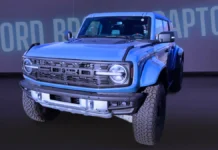Despite pushback from the automotive industry, the U.S. government confirms the implementation of life-saving safety technology (Automated Emergency Braking (AEB) systems) in all new vehicles.
NHTSA Upholds Automated Emergency Braking (AEB) Regulation, Marking a Milestone for Road Safety
This month, the National Highway Traffic Safety Administration (NHTSA) reaffirmed its decision to implement the mandatory installation of Automated Emergency Braking (AEB) systems in all new vehicles. This rule, initially proposed in April 2024, will come into effect by September 2029. The decision comes after years of debate within the automotive industry, as well as delays in the technology’s rollout. While many experts argue that this regulation will save lives and reduce injuries, it remains a point of contention for some automakers, who express concerns about the technical requirements and associated costs.
A Long Journey: From Voluntary Implementation to a Federal Mandate
The movement towards standardizing AEB began over eight years ago, driven by the U.S. Department of Transportation (DOT) and the Insurance Institute for Highway Safety (IIHS). The goal was to encourage automakers to voluntarily integrate AEB into their vehicles, a move that was initially well received by the industry. The idea was simple: reduce the number of collisions by equipping cars with technology capable of automatically braking when a potential crash is detected, whether with another vehicle or a pedestrian.
The results of these early efforts were promising. Most major automakers committed to incorporating AEB in their models, and at one point, the goal was to have Automated Emergency Braking (AEB) installed in 99% of new vehicles sold in the U.S. by 2025. However, as time passed, the process slowed down, and the deadlines were repeatedly pushed back. Initially planned for 2022, the timeline was extended, and in June 2023, the NHTSA proposed a revised rule, with a final implementation date of 2028 or 2029. This official regulation was solidified in April 2024.
Automakers’ Objections: A Regulation Seen as Overly Restrictive

Despite NHTSA’s final rule, many in the automotive industry continue to push back. In June 2024, the Alliance for Automotive Innovation (AAI), representing major car manufacturers and suppliers, sent a letter to NHTSA highlighting concerns. The AAI includes giants like General Motors, Ford, Toyota, and Volkswagen, along with parts suppliers. The letter raised five specific technical issues with the rule.
One major concern is the requirement that AEB systems avoid collisions with vehicles or pedestrians without any contact during tests. The AAI argued that this was impractical and unrealistic. Another issue is the rule’s requirement for malfunctioning systems to trigger a Malfunction Indicator Lamp (MIL) in all cases. The AAI felt this would create unnecessary complications and may not reflect real-world conditions.
The AAI also questioned the lack of options for manual deactivation of AEB in certain driving scenarios. They argued that the system could become unpredictably aggressive, causing unwanted braking in some conditions, which could endanger drivers.
Despite these objections, the AAI emphasized their willingness to work with NHTSA. They expressed a desire for more collaboration to make AEB systems practical, both for manufacturers and consumers.
NHTSA’s Response: No Reconsideration
In the face of these objections, the NHTSA has made it clear that it will not revisit the rule. A spokesperson for the agency clarified that while NHTSA had reviewed and addressed some technical requests, such as clarifying requirements for forward-collision warning signals and adjusting pedestrian test scenarios, they would not be making any further changes to the rule. The effective date remains September 2029.
The decision has been supported by groups like the National Transportation Safety Board (NTSB), which has long advocated for the adoption of collision avoidance technologies. NTSB Chair Jennifer Homendy emphasized that research from the NTSB had consistently shown that technologies like AEB could prevent accidents and save lives. “For nearly three decades, we have recommended that collision avoidance technologies be mandatory in all vehicles,” Homendy said. “This is why we strongly support this rule.”
Global Context: Automated Emergency Braking (AEB) Regulations Expanding Worldwide

The push for AEB technology is not confined to the United States. Both Europe and Asia are implementing similar regulations. In the European Union, for example, all new vehicles are expected to be equipped with AEB systems by 2022. This international movement towards standardized vehicle safety features means that the U.S. government must ensure that its regulations align with global standards to avoid discrepancies and to maintain the competitive edge of American automakers.
The global push for Automated Emergency Braking (AEB) also highlights how important it is for the U.S. to stay in step with its international counterparts. As more countries adopt similar measures, manufacturers will need to adjust their designs to meet the requirements in multiple regions, adding to the complexity and cost of compliance. Nevertheless, the push for standardization remains essential for improving road safety worldwide.
The Road Ahead: The Benefits of AEB for Consumers and the Insurance Industry
As AEB systems become more widespread, their benefits go beyond just reducing collisions and saving lives. The technology could also have significant financial implications, particularly in the insurance industry. AEB can reduce both the number and severity of accidents. This could lower car insurance costs for consumers and insurers. Many insurers already offer discounts to drivers with AEB-equipped vehicles, recognizing its value in preventing crashes.
The main challenge is making this technology accessible to all consumers without straining their finances. NHTSA aims to balance innovation with affordability. The goal is for Automated Emergency Braking (AEB) to become a standard feature without raising vehicle prices too much. As with other safety technologies, widespread adoption will depend on striking the right balance between cost and effectiveness.
A New Era of Road Safety
The implementation of Automated Emergency Braking (AEB) represents one of the most significant advancements in vehicle safety in recent decades. Despite resistance from parts of the automotive industry, AEB holds the potential to dramatically reduce traffic accidents and fatalities. As NHTSA moves forward with its plan to make AEB standard in all new vehicles by 2029, it will be crucial to monitor how the industry adapts to this new mandate and how the technology evolves over time.
For now, the priority is to ensure AEB systems are developed in a way that benefits consumers and improves road safety. These systems must reduce accidents effectively. Collaboration between government agencies, automakers, and safety groups is key. With continued effort, AEB technology has the potential to save thousands of lives annually. The future looks bright for this life-saving technology.





















